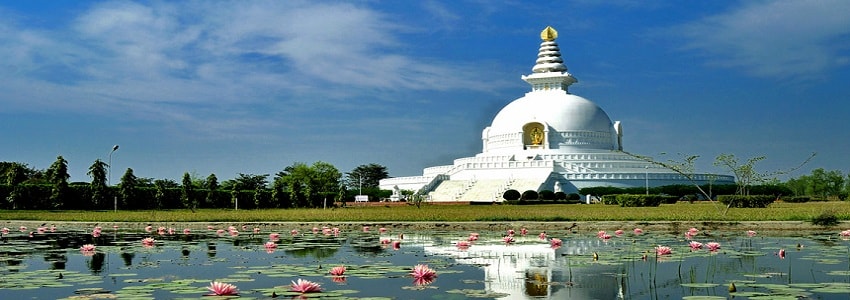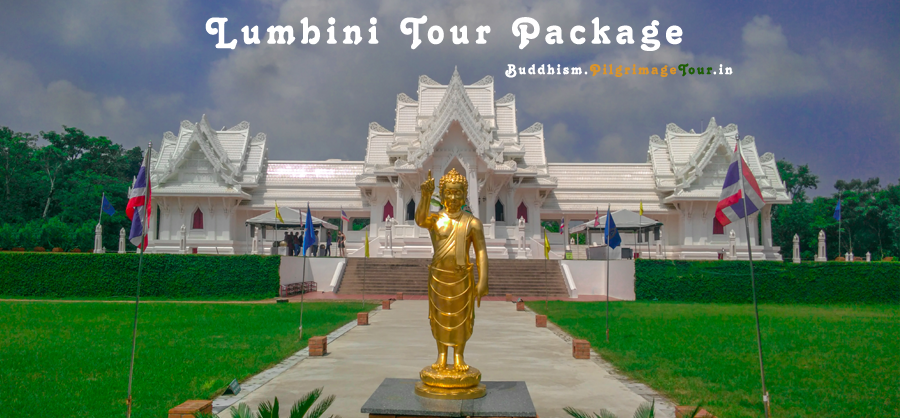Nearly 2600 years ago, one of the greatest of spiritual Teachers to have changed the course of human evolution took birth in Lumbini. We know him as Buddha, the enlightened one. The holy land the divine soul chose to take the last of his re-births before being free forever of the endless cycles of birth, death and re-birth is known to the world today as Lumbini, thanks to the efforts of many who kept the memory of the holy birth alive across the many eons starting from Emperor Ashoka’s commemorating the sacred land with building of stupa to UNESCO’s declaration of the site as a world heritage site.
‘Lumbini’ in the native language translates to ‘the lovely’. This lovely stretch of land houses not one but many archeological relics belonging to different points in human history. What, though, forms the heart of the entire stretch is Maya Devi Temple. The temple is believed to have been built over the very spot at which Maya Devi, Queen of Kapilavastu, gave birth to Siddhartha Gautama. A 14th century sandstone carving depicting the momentous birth forms the kernel of the sacred shrine. It depicts Maya Devi holding the branch of a ‘Sal’ tree as baby Buddha is being born, with gods in the sky gazing at the auspicious moment. A stone encased inside glass located under the illustrative representation allegedly pinpoints the precise point in space where the greatest of enlightened masters took his birth at.
Legend of Buddha’s birth

Maya Devi is believed to have undergone a very painless and natural childbirth. In fact, the fully pregnant queen was on her way to her parents’ home from her kingdom of Kapilvastu when she chose to take a short retreat at the scenic garden of Lumbini. She bathed in the waters of its central pond and had hardly taken twenty steps before she went into labour. Her holding the twig of a Sal tree while giving birth to the young prince is immortalized in the stone craving and many written inscriptions that survive to this day. It is said that they were looked upon and blessed by several divine beings at this sacred instant and that the infant took seven baby steps immediately after his entering this corporeal world. Lotus flowers are said to have bloomed wheresoever the tiny feet fell to the ground. The new born was given his first bath in the waters of the same sacred pond. The story takes a tragic turn with Maya Devi’s death seven days after the child-birth. The baby was subsequently taken care of by Mahaprajapati, Maya Devi’s sister.
Other attractions in Lumbini
The two millennia old temple forms the centre but not the only attraction Lumbini offers. The blessed pond in which Maya Devi and baby Siddhartha took bath is located adjacent to the temple. The sacred complex at Lumbini also houses a sandstone pillar erected by Mauryan Emperor Ashoka. The archeological remains of Maya Devi Temple range in age from third century BCE and twenty first century CE. Also, archeologists have excavated remnants of many Budhhists shrines and monasteries that existed between third century BCE and fifteenth century AD.
The garden surrounding the complex which contains the many historically significant relics like Ashoka’s pillar and the remains of Buddhist shrines over the many years is adorned by an enormous Bodhi tree. Myriad prayer flags tied to its branches flutter with every tiny whiff of wind.
A 41 m tall Japan Peace Stupa adorns the northern boundary of Lumbini gardens. While the Lumbini Museum protects artifacts, religious inscriptitions and other archeologically extracted items that have been obtained from the very premises of Lumbini. The beautiful structure of Golden Temple is another major tourist attraction in Lumbini.
The 4.8 km lengthy and 1.6 km wide stretch of land in Lumbini is surrounded in an enormous monastery-only zone. One cannot come across a single shop, restaurant, hotel or commercial building as far as eyes can see while at this sacred site. Lumbini attracts pilgrims and seekers from around the world. One would be greeted by sacred chanting as soon as one enters the premises of this holy site. Meditation practices and sacred chanting go on from dawn till dusk at Lumbini.
History of Lumbini

The world owes its debt to Emperor Ashoka for marking the sacred site of the origin of Lord Buddha by building a stupa and leaving behind an inscription citing the land as the place where baby Buddha was birthed by Maya Devi. It is to be noted that Buddha is estimated to have lived between 563/480 BCE- 483/400 BCE while King AShoka’s reign was between 268 BCE and 232 BCE. Lumbini finds itself mentioned in the travel writings of Chinese pilgrims Faxian(337-422 CE) and Huan Tsang(602-664 CE). The control of the area passed onto the hands of Hindu and Muslim rulers, which lead to the destruction of many of its structures and its being lost to the memory of the world. It was in 1895 that a German archeologist namely Alois Fuhrer rediscovered the site. Twentieth century witnessed many other archeological excavations leading to restoration of most of the temple garden complex of Lumbini.



